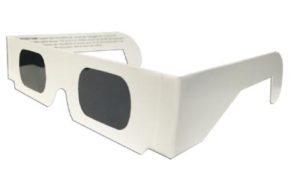The Night Sky: The Sky in July 2017
by Dee Sharples –
A couple simple “tools” will help you observe the night sky, and neither of them are a telescope. You can see some wonderful sights with your eyes just by looking up.
First you need to know the four compass point directions at your observing site. Which way is south? That’s the direction where the sun is highest in the sky around 1:00 PM in the summer. Face south – east is on your left, west is on your right and north is behind you. The sun rises very early in the east-northeast in the summer and appears to move from east, to high in the south, to west throughout the day. But it’s actually the Earth rotating on its axis in a 24-hour cycle that creates the illusion that the sun is traveling across the sky.
The second tool is to know ho w to measure degrees in the sky. A simple “ruler” is to hold your arm out, directly in front of you and parallel to the ground and make a fist. The area covered by your fist measures roughly 10 degrees. The ground below your extended fist, is at 0 degrees. Straight up is 90 degrees. By moving your fist up and counting how many “fist-widths” it takes to reach an object in the sky, you’ll have a pretty close estimate of your target’s location.
w to measure degrees in the sky. A simple “ruler” is to hold your arm out, directly in front of you and parallel to the ground and make a fist. The area covered by your fist measures roughly 10 degrees. The ground below your extended fist, is at 0 degrees. Straight up is 90 degrees. By moving your fist up and counting how many “fist-widths” it takes to reach an object in the sky, you’ll have a pretty close estimate of your target’s location.
You can use these tools to find the giant planet Jupiter this month. Look for it shining like a very bright star at Magnitude (Mag.) –2.0 in the southwest as the sky darkens, about 40 degrees (4 fist-widths) up from the horizon.
The ringed planet Saturn will be a little more difficult to find as it will be dimmer than Jupiter and shine only at Mag. 0.2. Magnitude measures the brightness of a celestial object, and opposite of what you might expect, the higher the number the dimmer the object. On July 1, Saturn will be no higher than 30 degrees (3 fist-widths) above the horizon in the south around midnight. Each week after that, the planet will reach the same position in the sky about 30 minutes earlier. The moon will help you find Saturn at 11:00 PM on July 6 when it passes just above the planet. To view Saturn and its beautiful rings through a telescope, visit the Strasenburgh Planetarium this month (see insert).
The Earth will reach aphelion on July 3. Aphelion is the point at which Earth is farthest from the sun, 94.5 million miles. Contrary to what many people believe, Earth’s varying distance from the sun plays no part in the seasons. For the northern hemisphere, summer happens to occur when Earth is farthest from the sun. We have summer with its longer days and hotter temperatures because the Earth is tipped on its axis and its northern hemisphere is leaning toward the sun creating longer days. This tilt also causes the sun to be at a higher angle in the sky and shine more directly on us. In winter, Earth is actually closer to the sun. Because our orbit around the sun is an ellipse and not a perfect circle, our distance from the sun changes throughout the year.
The planet Venus can be seen in the early morning, rising in the east before the sun is up. You can’t miss it as it looks like a dazzling bright star at Mag. -4.1 fairly close to the horizon.
The Southern Delta Aquariid meteor shower peaks around 4:00 am in the early morning hours of July 30. From a dark sky site you can expect to see a meteor about every 3 minutes. From July 27 to August 1, you will be able to see some meteors but less of them. The radiant, or area from which the meteors will appear to originate, will be in the constellation Aquarius low in the south but you’ll be able to spot a Delta Aquariid meteor shooting across the sky in any direction.
 There will be a total solar eclipse in some parts of the United States on August 21, 2017. Although New York State will see only about 70% of the sun blocked by the Moon, hopefully we will have clear skies in our area that day to experience it. It’s imperative to wear proper eye protection when viewing any part of the eclipse to prevent damage to your vision. Sunglasses will not protect your eyes. Inexpensive solar eclipse viewing glasses can be ordered on-line at various sites and prices or purchased at the Rochester Museum and Science Center for $2.00 a pair.
There will be a total solar eclipse in some parts of the United States on August 21, 2017. Although New York State will see only about 70% of the sun blocked by the Moon, hopefully we will have clear skies in our area that day to experience it. It’s imperative to wear proper eye protection when viewing any part of the eclipse to prevent damage to your vision. Sunglasses will not protect your eyes. Inexpensive solar eclipse viewing glasses can be ordered on-line at various sites and prices or purchased at the Rochester Museum and Science Center for $2.00 a pair.